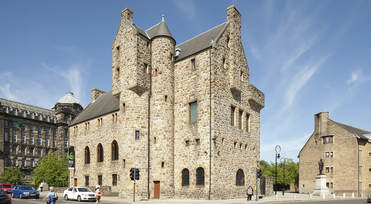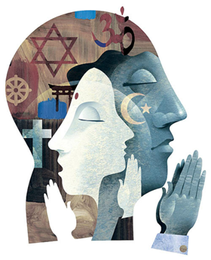
Mark O’Neil who was the original creator of the museum and whose vision brought it into being told us the story of its origins. The building itself was erected by Glasgow Cathedral as a visitors centre but when money ran out to staff the centre it was handed over to Glasgow City Council. The inspiration to turn it into a museum of religion came from no-where, said Mark. He was very aware of the large number of religious artefacts in Glasgow’s collection and of curators’ hesitancy in dealing with them. Most curators were happy to relegate artefacts (celtic cross for example) to the category of history or archaeology rather than religion. At the time there was only one other museum of religion (apart from a museum of atheism in St Petersburg) and that was in the University of Marburg in Germany. Now there are five museums of religion in the world and Glasgow can boast of being the second of these.
Right from the start the local interfaith group, the Glasgow Sharing of Faiths, was consulted. I remember that initial meeting and found the idea interesting and even compelling but was not at all aware of how significant the museum was to be in my life. Most religions took to the idea apart from the Churches. Both the Catholic Church and the Church of Scotland were very unsure of the idea and very unsure of the reality when it was opened. This was because artefacts from different religions which reflected common themes and devotions were set out side by side. So we had a statue of the Virgin Mary and her son Jesus next to one of the Goddess Isis and her son Horus – both with child seated on the lap of their mother. We had baby Jesus, baby Krishna and baby Buddha side by side. For some people, I remember, this was seen as compromising the integrity and purity of faith. It was a challenge for some to realise that religions had common expressions. I loved it. It put any one religion into perspective and was truly educational in that it helped people look at religion objectively. But it did also have a display which set out the basic beliefs and tenets of each of the faiths so the museum didn’t deny the integrity of each faith.
The reason St Mungo’s became so significant for me was that right from the start it was committed to dialogue. It organised educational events but always in a dialogical and interfaith way. For about fifteen years I was part of a group that put on an annual Meet Your Neighbour event. The major faiths (especially the ones that were already engaged in dialogue) put on some kind of display about their faith over a weekend. But as well as that, we had activities of all sorts and often musical interludes. We often had a concert on the Sunday afternoon and I have vivid memories of the conference room being so packed that we opened the glass doors that formed one wall of the room so that people could stand outside and look in. The high point of this was the tenth anniversary when we decorated the museum and had a great party with circle dancing and singing and all sorts of jollities. The thought of it brings a smile to my face. These were happy days though of course they had their own stresses and strains.
I eventually came to work from St Mungo’s. When we set up the national interfaith body of Scotland (then called the Scottish Interfaith Council and now Interfaith Scotland) we were given the use of a desk by Glasgow City Council, the gift of a computer by my community (the Sisters of Notre Dame) and my services. These were small beginnings with no funding whatsoever. St Mungo’s Museum was very important in those early days, giving us room for dialogues and support in so many ways. The council only moved out of St Mungo’s when we were given funding by the Scottish Government and were able to employ a development worker and part time administrator. Since then Interfaith Scotland has found premises with a meeting room large enough to use for dialogues but Interfaith Glasgow continues to work in partnership with St Mungo’s and it continues to encourage dialogue between people of all faiths and none in so many interesting and challenging ways.
St Mungo’s Museum definitely has a very important place in the history of interfaith in Scotland. The faith communities in Glasgow always felt very at home in it and very supported by the staff. At one point there was a move to close the museum but the response from faith communities was so great that the decision was reversed. It’s a loved institution and shows so clearly how important secular institutions are in developing dialogue between faiths. Sometimes they can offer more challenging and interesting dialogues than interfaith groups can, they can reach people beyond the usual religious groupings and draw in a much wider audience in their educational and dialogue work. Here’s to them and to a bright future for all of them but particularly for St Mungo’s.



 RSS Feed
RSS Feed
